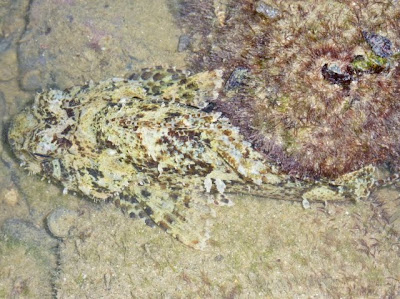During the last trip of this low tide series, we decided to go slow and easy and visit Tanah Merah.
We started off during sunset. With the cool weather and a tranquil environment, this definitely beats going to a crowded shopping centre on a weekend evening. There were lots of interesting creatures waiting for us to explore.
There were two patches of Ribbon seagrass (Cymodocea rotundata) and among these seagrasses are numerous patterned Dubious nerites (Clithon oualaniensis) and Creeper snails (Family Cerithiidae).
There was even another patch belonging to Sickle seagrass (Thalassia hemprichii).
Among the seaweed, Chay Hoon spotted this tiny weeny feather star. Probably the smallest I've ever seen. When she told me that there's a feather star in this seaweed, I asked where is it. Can't see it even when told. Indeed, only CH can spot all these small creatures.
The Ornate leaf slugs (Elysia ornata) are still in season and are abundantly found on the shores.
This fish on top of the seaweed is the Variable fang-blenny (Petroscirtes variabilis).
As you probably know, there's lots of fishes to spot at Tanah Merah. But the fishies are too hard to photograph as they are relatively shy. It's my first time being able to take a photo of this big grouper. It is the Chocolate hind (Cephalopholis boenak).
I dipped my underwater camera to shoot this fish that is less shy. It is probably the Spotted scat (Scatophagus argus). It remained rather motionless, probably it was still sleeping?!
This fish eats detritus and algae from the sea bottom. It also eats droppings of other animals including ours. Its scientific name 'scatophagus' means 'shit-eater'!
Somehow, there were quite a number of small filefishes spotted. Some of them hide among the seaweed like this Bristle tail filefish.
This Painted scorpionfish (Parascorpaena picta) looks like the Hollow-cheeked stonefish (Synanceia horrida). Both can inject venom if stepped on, the latter is more serious. Thank God I managed to escape from the stonefish during this trip.
Among the sandy shore, I found this Diamond tuskfish (Halichoeres dussumieri). They tend to be found semi-buried in substrates like sand. I wonder why.
One of the more special fishes found during the trip will be this large fish that I thought it was the Needlefish or Garfish (Family Belonidae). But Ria later mentioned in her blog that it could be an older version of this smaller halfbeak with a short 'nose'.
I was checking out the interior of some parts of the seawall that can be entered, with caution to look out for stonefish. And I had a pleasant surprise to find some sandy spots within that had some Common sea stars (Archaster typicus).
Also among the seawall rocks is this only sea cucumber find: the Synaptic sea cumuber. It is sometimes mistaken as a worm or even a snake!
This pinkish worm-looking animal is a real worm. I've seen this before but still do not know what kind of worm this is.
This fan-looking animal is also a worm and it is the Orange fanworm.
This fanworm however is not as commonly sighted. This is probably the Spotted fanworm.
The only special nem spotted will be this Plain sea anemone. It's my first time seeing it relaxed and "expanded" in the water.
I had my camera go another dip underwater and captured the view of its orange body column.
On some parts of the shore, there are some zoanthids like this patch of Button zoanthids (Zoanthus sp.).
Among the fast moving animals, this Two-spot reef octopus must be one of the best candidates. It was gliding across rocks and crevices real quickly, not forgetting to change colours to suit its environment.
I went to some higher parts of the seawall and found this Spotted-belly forceps crab (Ozius guttatus). This is probably the first record for Tanah Merah!
This crab has a large, oval body that is smooth and lacks patterns on the upperside. It has lots of tiny spots on its belly. Their eyes have small spots and their pincer tips may be orange, reddish or brown.
For some reasons, there were plentiful of the Dwarf turban snails (Turbo bruneus) found during this trip.
Another mollusc on the shore will be the Firebrand murex snails (Chicoreus torrefactus).
After the end of the trip, I came across this terrestrial flatworm on the trail back. This is quite interesting. :)
Tuesday, December 8, 2009
Slow and easy at Tanah Merah
Subscribe to:
Post Comments (Atom)






























No comments:
Post a Comment